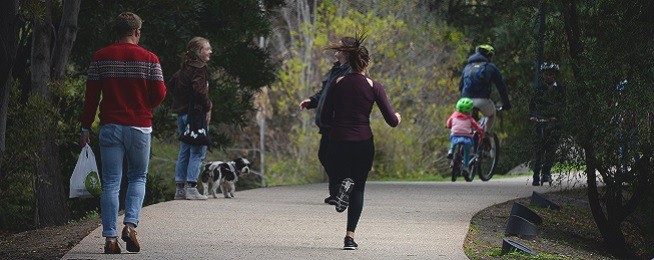By Alison Hetherington, Public Affairs Manager Tasmania
Like most of us, I’ve been leaving home each day to exercise or get food, and in the case of bicycle riding killing two birds with the one stone.
It’s been fascinating to see the transformation of my local streets. Places that are usually car dominated are now more of a balance of cars and people out walking, riding and running. Sometimes, I count more people outside of cars than in them.
Whole families are trundling down footpaths, couples are out riding, some riders like me are heading to the shops with baskets and panniers, and other solo riders are out in their lycra getting much needed exercise.
People who may not have walked or ridden around their neighbourhood are doing it to get out of the house, get exercise now their gym is closed or to avoid being near others on a bus.
Whatever the reason, more people walking and riding is good for physical and mental health and is something we should be strongly supporting.
But by getting out and about they are finding their local streets aren’t really equipped for a virus pandemic that requires us to stay 1.5 metres away from others.
Most of our footpaths are less than 1.5 metres wide and most of our streets don’t have protected cycleways for those less confident riders who can’t fit on to the footpath but don’t want to ride with traffic.
To do the right thing and physically distance, people are having to walk and ride in road space allocated to cars because the footpath is not wide enough.
In Hobart we can all cite examples of where we’ve seen too many people trying to use inadequate infrastructure: Channel Highway, Battery Point, Glenorchy Main Rd, Kingston Beach, Elizabeth Street.
At the same time, there are fewer cars on the road and in commercial areas less need for on-street parking.
Other cities have recognised that physical distancing is here for the long haul and are quickly converting road space to places for people walking and riding: Berlin, New York, Mexico City, Boston, Bogota and Vancouver, to name a few.
Sydney’s Centennial Parklands closed to traffic over Easter to make space for people walking and riding and all the photos on social media show people embracing the extra space.
Some cities are also seizing the opportunity of less traffic to trial the kinds of projects that have been talked about for years – wider footpaths, separated cycleways, slow-speed shared zones and car-free streets.
The New Zealand Government has announced it will provide local councils with 90% of project funding to trial wider footpaths and protected bike lanes. They will be able to quickly roll out the temporary infrastructure by using bollards, planter boxes and paint to repurpose road space.
In Hobart we could trial separated cycleways that link existing infrastructure to start forming a useful cycling network: Davey Street, Collins Street, Campbell Street and Elizabeth Street would be a good start.
The Tasman Bridge is also crying out for one of the traffic lanes to be sectioned off by bollards so people can walk and ride between the two sides of the city without literally bumping into others on the narrow paths.
Bicycle Network has written to the Minister for Infrastructure and greater Hobart mayors to support any moves to create more space for people walking and riding.
For all the pain and loss that has come from this crisis, there is a chance for the government and councils to make the most of the quiet roads to trial the changes needed to modernise Hobart’s streets.
First published in The Mercury, 17 April 2020
Become our friend
Find out more about Bicycle Network and support us in making it easier for people to ride bikes.



